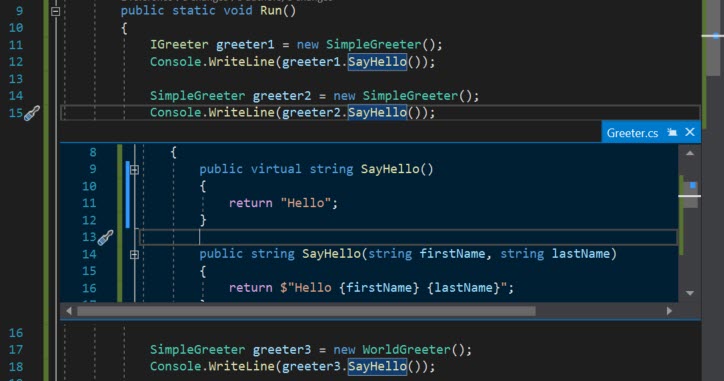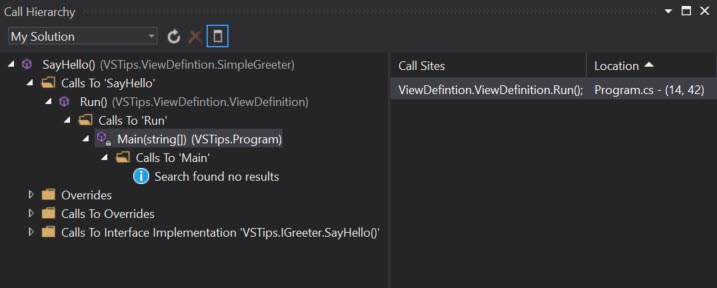Visual Studio Tips - Code Definition Keyboard Shortcuts
April 24, 2019 in VSTipsOften when we’re coding, we need to take a look at the definition or sometimes the implementation of a method we’re calling. Visual Studio has a few great ways to speed these tasks.
Goto Definition
To see the definition of a variable, class, interface or method, you place your cursor on the thing you want to see the definition of, and either press F12 or right click and choose Goto Definition.
One catch with Goto Definition is that when you use it to go to a definition of a property or method, it goes it goes to the definition of the object as it is declared. That means that if you hit F12 on all of the SayHello() methods below you would go to IGreeter.SayHello for greeter1, SimpleGreeter.SayHello for greeter2 and greeter3 and WorldGreeter.SayHello() for greeter4.
IGreeter greeter1 = new SimpleGreeter();
Console.WriteLine(greeter1.SayHello());
SimpleGreeter greeter2 = new SimpleGreeter();
Console.WriteLine(greeter2.SayHello());
SimpleGreeter greeter3 = new WorldGreeter();
Console.WriteLine(greeter3.SayHello());
WorldGreeter greeter4 = new WorldGreeter();
Console.WriteLine(greeter4.SayHello());
Peek Definition
If you wanted to take a peek at the definition without navigating to its definition, you can use Alt+F12 or right click and choose Peek Definition. This brings up the definition in a little window within the code editor. You can still scroll through the code of the definition without losing your place in the code you are editing. Esc closes the Peek window.

Goto Implementation
If you want to view the implementation of a method or property rather than its definition you can press Ctrl+F12 or right click and choose Goto Implementation. If there is only one implementation for a method, Visual Studio takes you directly to the implementation. If there are multiple implementations, it brings up a window that lists the implementations. You can view the implementations by using your arrow keys or by clicking on them.
For the code above it would go directly to the implementation for greeter4.SayHello(), for all the others it would bring up the implementation selector window.
Find All References
Sometimes it’s helpful to see what other code is referencing a method or property. For that, you can use the official shortcut Ctrl+K+R, or the unlisted shortcut Shift+F12, or you can right click and choose Find All References. This brings up a window that lists all the references to that method. This displays the same list regardless of how the object is declared.
View Call Hierarchy
Sometimes it is handy to be able to see what code is calling a method or property, and what code led to that call. To see that you can right click on the method or property you’re interested in and choose ‘View Call Hierarchy’ or Ctrl+K, Ctrl+T. This brings up a tree view with the method or property you’re interested in and allows you to dig in until you get to the initial action that caused the method or property to be called. In the case below we can see that the SayHello() method was called by the Run() method which was called by the Main([string]). In the right pane, we can see the line and column that Run() is called from and double-clicking that takes us to that location.

Have a comment or suggestion? This blog takes pull requests.Or you can just open an issue.